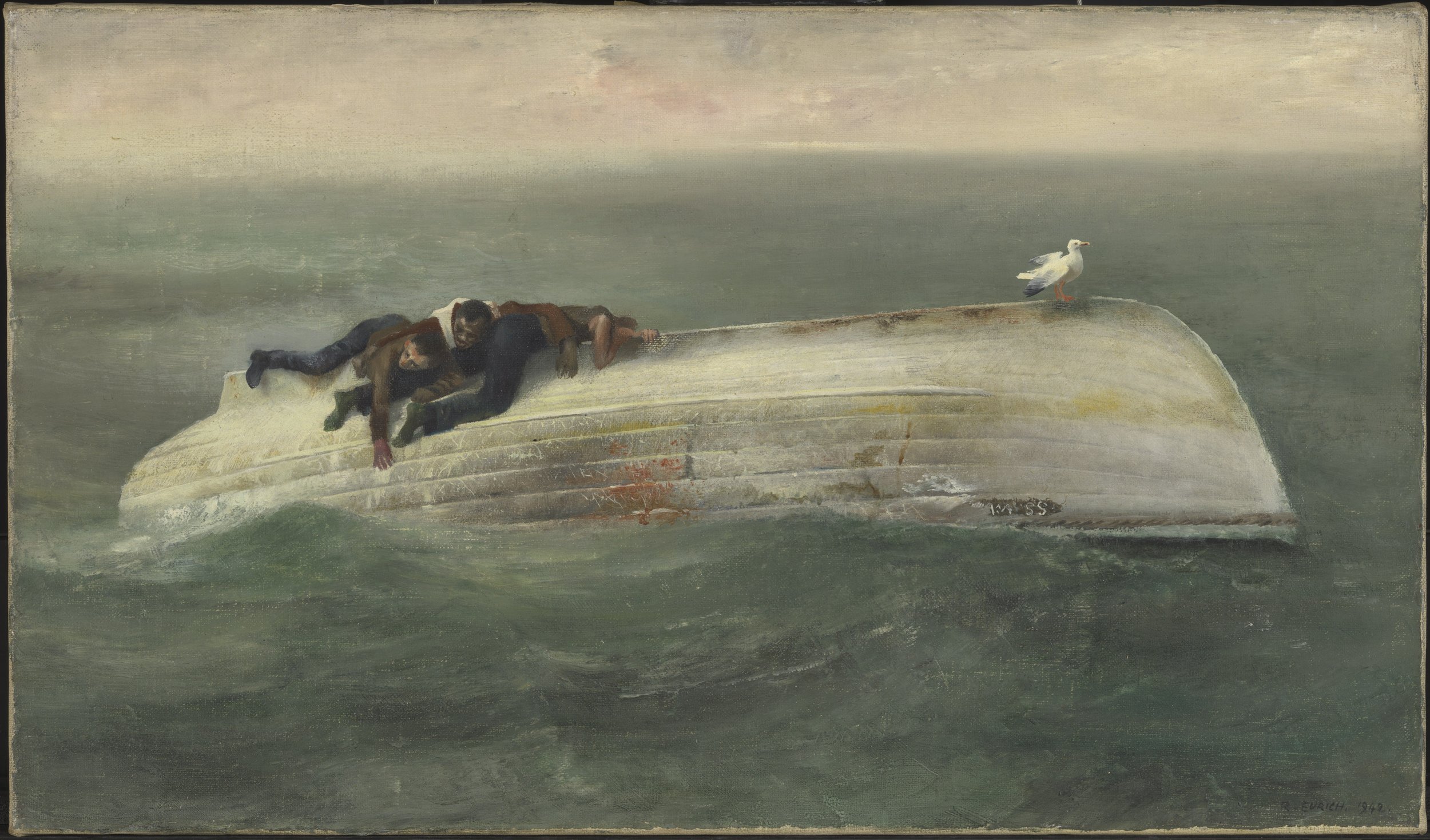Sink or swim
Richard Eurich Survivors from a Torpedoed Ship 1942 © Tate
Ten years after it first opened, Hastings Contemporary marks the moment with a Seafaring, a fitting exhibition of about 50 works. The galleries and circulation spaces are wearing well and the good café is staffed with gusto, which all adds to the charm of an ancient fishing town with higgledy streets, a funicular (currently being renovated); an endlessly long beach of shingle, and too many seagulls for their own good. Throw in a small seafaring museum in an old chapel (free) and it’s definitely worth a jaunt.
What is on show offers a very varied and intelligent commentary on the danger and power of the oceans in relation to quite often small boats. They cover war and shipwreck on boat and submarine (there’s a little-known, unexpected set of five works by Eric Ravilious, done while a Marine Officer stationed in Gosport features, for example, submariners levelling their ship, which for some reason the artist originally thought would interest children as a colouring book) — as well as some welcome lighter touches from the likes of Edward Ardizzone and Chris Orr.
Chris Orr Small Titanic Etching 1993 © Private Collection
A first room sets a historical note with two linked photographic reproductions of unavailable paintings, one by Théodore Géricault, one by Eugène Delacroix inspired by it. This second, slightly confusingly placed first on the wall, Christ Asleep During the Tempest, is shown in tandem with but not beside its accompanying, rare pencil sketch, beautifully done.
Géricault painted The Raft of the Medusa in 1818 in his late twenties, only a few years before his death. The vast, seven-metre long painting of the 15 survivors of a French frigate that had run aground, barely alive on a raft breaking apart in lashing seas, the mast and sail collapsing, drew 40,000 viewers and caused a literal sensation. No painter had tackled such a theme in such a strikingly graphic, pathetic and moving way. It was a scene from hell and it stirred the French soul.
Photographic reproduction of Théodore Géricault: The Raft of the Medusa. Louvre Paris. Image Stockley.
In 1853, Delacroix’s Christ Asleep shows Christ peacefully oblivious as the waves lash a small rowing boat whose inhabitants, men and women, are full of anguish and fear of death.
As well as Delacroix, Géricault’s work also inspired Martin Kippenberger to a set of modern lithographs that are also on display in this room.
These Romantic European works nicely contextualise three vivid, fluid paintings by Cecily Brown from around 2017, in a joined room of their own. Each large painting is full of rhythmic sweeps of movement, suggesting a rocking boat or the roll of waves; each, with glistening, confident and frequent overlapping passes of paint can seem at different moments to suggest bodies; limbs; gulls; waves; tormented faces … abstract undoubtedly, yet these are certainly paintings of and from the sea and are populated in a remarkable way. A bit like a distorting mirror the only way to experience them is to go and stand in front of them. The largest and brightest, Oinops, with black strafed throughout its coral-toned palette, concentrating at the core, somehow conveys the most panic and menace.
Cecily Brown Oinops 2016-2017 © Cecily Brown. Courtesy the artist and Thomas Dane Gallery
The show widens out with an extraordinary array of — mainly — paintings that include Maggi Hambling’s monumental 2016 of a blue sea with an upturned yellow boat (though to my eyes it might also be a blue whale coming up); a huge Hughie O’Donohue on trademark oilcloth of a wrecked hulk of a cargo ship (Wake II); two Elizabeth Frinks, two James Tissots, and numerous fascinating others.
Maggi Hambling 2016 (c) Maggi Hambling. All rights reserved 2020, Bridgeman Images
One extraordinary story that catches the imagination and surely has a film somewhere in its bizarreness is the story of Dazzle ships. In the First World War, painter Norman Wilkinson came up with the idea, which the navy embraced, of painting ships with abstract patterns with the intention of confusing enemy submarines of the vessels’ direction. Did they? It seems improbable. But then so did Operation Mincemeat in the Second World War. But the idea resulted in some abstracted, wonderful paintings of these bizarre zebra-like ships by John Duncan Fergusson and Edward Wadsworth.
Edward Wadsworth Dazzle Ships 1918 Wood Engraving Private Collection. Image Stockley
Meanwhile, perhaps the most genuinely surreal and provocative work on show is a fairly large painting by that very man who came up with the Dazzling idea, Norman Wilkinson. In the middle of a brilliant flat sea, where sea and sky almost merge in a startling, semi-pointilist effect, a briefly sketched figure of a man wearing a cap and grey trousers stands, back turned, staring out somewhere, on the far edge of a large, well made Robinson-Crusoe sort of raft. Also on the raft are a few random objects: a green cupboard door, a tarp, and what appears to be a dead body lying on its side, wrapped in a white cloth. The title of this painting, The Sole Survivor, is itself enigmatic and chilling. There are no more clues.
Norman Wilkinson The Sole Survivor. 1940s. Royal Museums Greenwich. Image Stockley
The sea’s massive power to give and to take (on the evidence of this show, perhaps more to take) are on splendid, plentiful display, while its power to attract artists across the centuries is too, with a gentle swell towards modern.
SEAFARING
Hastings Contemporary, Hastings, Sussex.
30 April – 25 September 2022
No images from this blog may be copied or used in any way







